House Diary: Lammas
[Cover image: The Corn Wheel I made in the early 1990s is still serviceable as the center attraction for the Lammas season, evoking corn, one of the glories of August, as well as anticipating autumn, with its use of Indian corn for the spokes representing the eightfold year.]
Lammas, August 1st, is the celebration of the First Harvest, that of grains. It takes its name from an Anglo-Saxon term meaning “loaf-mass”, a day when early Christians brought their milled grain and fresh-baked breads to be blessed by the Church. As with so much of Christian lore, the tradition has its roots in prior pagan practice, and Lammas has been honored by nature religions for the first fruits of the earth time out of mind. The earlier pagan term is Lughnasadh (pronounced “loo-nah’-sah”), named for the annual games held in honor of the Celtic deity Lugh (“Loo”), god of light. It was a day for gathering the clans, feasting on the abundant produce, friendly competition, horse trading and “handfasting”, a remarkably sensible mating ritual whereby a couple agrees to cohabit for a year before final vows are exchanged, just to be certain they’re compatible.
Here in the garden it’s been a blisteringly hot and dry summer, which spells trouble for yours truly and the errant well. So far, adhering to a carefully spaced watering schedule utilizing zones, I have averted a second incident of the well running dry, and a few drenching summer thunderstorms have helped. We’re having one of those days as I write, on Lammas Eve, so I’m taking advantage of my break in water drills to start composing this entry.

Part of the western perennial border, featuring tiger lilies, purple coneflower and brown-eyed Susan
And I’ll begin with a quatrain I penned so many decades ago, to encapsulate the archetypal elements of the Lammas season:
“Sunflowers bloom while fireflies dance, and locusts are heard in the trees;
The Sun’s heading back to his southerly stance, and O! what we’d give for a breeze!
It’s Lammas! First Harvest! So be of good cheer!
As we feast on blackberries, rich cornbread, and sweet honey beer.”
My own harvest is coming along nicely, though it’s mainly inedible. I do have a profusion of potted herbs – basil, chives, thyme, rosemary and parsley – which are thriving in their full sun location atop the sand mound. It’s a true joy to step outside your door and pluck a few herbs for the meal you’re preparing, so fresh and vibrant.
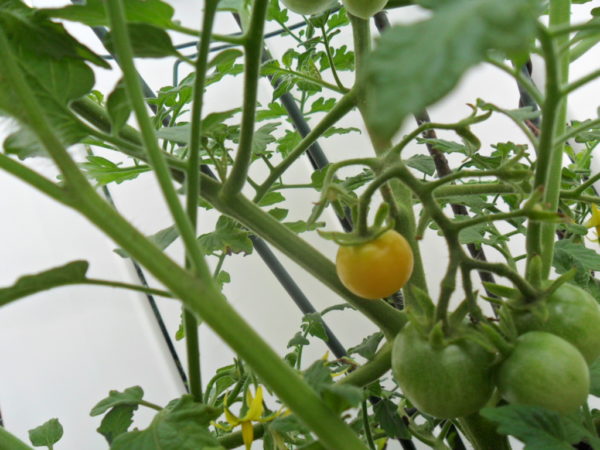
My first cherry tomato ripens on the vine, a few days before picking; the plant is now producing enough for a decent salad daily
I picked my first cherry tomato – a sweet orange variety called “Sun Gold”, on July 4th; the plant is now producing a half dozen or so daily, and there are several huge, slowly ripening fruits hanging on the Pineapple Tomato, an heirloom with banded red and yellow flesh. Heirloom tomatoes don’t produce the way hybrids do (and I’ll never get the type of yield my father got from them – he kept careful count and his record crop, from one plant in 1983, was almost 750!), but they’re a heckuva lot prettier and have better flavor, to my mind. Plus, I enjoy the nostalgia. And what would I do with hundreds?
Pineapple Tomato isn’t my favorite, which is Cherokee Purple, but due to a late killing frost that took those seedlings, that variety was unavailable locally this year. I even had a small harvest of yellow wax beans, planted in long narrow pots; not enough for August’s traditional PA Dutch string beans and ham meal, but a nice couple side servings for the chicken pot pie. I had less than a dozen plants, not all of which bore well; next year I’ll sow more.
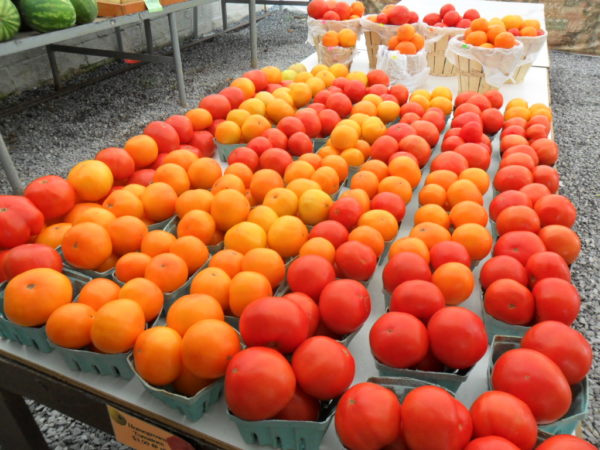
Tomatoes are one of the glories of the season; here is an assemblage of farm-fresh varieties, viewed on a recent outing to Lancaster, PA
Of course, for this gardener, the big crop is flowers! After a great showing by the Asiatic lilies early in the season, by July the daylilies started to come in. I adore all my new varieties – in tones from creamy yellow through bright saffron, peach, pink, rusty red and purple. Contrasting eyes and throats make for a showy blossom, some of them huge, especially when compared to the rather sparse first-year growth of the plant. I lost only one of twenty over the winter, though another four or five have failed thus far to flower. But the leaves are vigorous, and I’m hoping next year we’ll have a full showing.
And they’re about to be joined by two dozen brethren! My perennial farm maven, Kay, introduced me to Kim at “House of Lilies”, a daylily farm in our area. It’s a unique business model: HoL is only open in July, when their daylilies are in full bloom. Guests walk through a series of meandering paths surrounded by beds absolutely bursting with daylilies planted cheek-by-jowl. You’re given a complete (13-page, single-spaced!) plant list and an order form; each variety is tagged, and when you see one you like, you write it on the order. You hand in the order, pay a small deposit, and go your merry way. Then in September the lilies are dug and you return to pick them up and fork over the balance. But that’s not much; these are by and large very reasonably priced – most I got were in the $8 range. Let me tell you, cheap and beautiful lilies, grown locally and already acclimated? I’m done with Brecks!
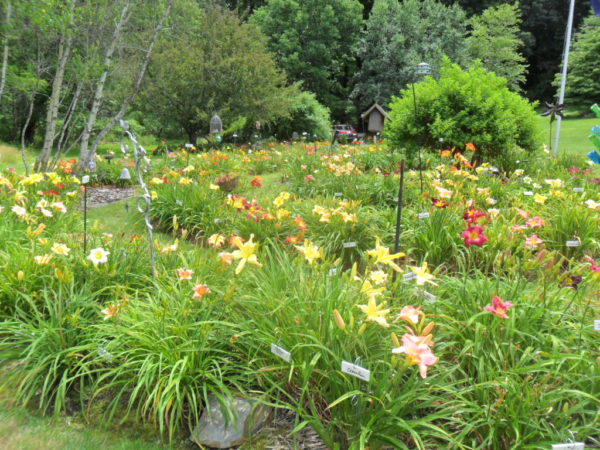
Just a small portion of the hundreds of daylilies on display at House of Lilies, a local farm where I purchased two dozen for next year
I only got a dozen on my first trip; the selection was so overwhelming, I just went wherever my eye drew me and marked it down. Once I got home, I googled every variety listed on the form, and captured pics of each, for a file where I could play with their combination and placement before they arrived for planting. I was dismayed to see that, with one exception, every lily I chose fell in the orange or purple color scheme!
Well, obviously I want a fuller palette than that! So I went back for a second dozen, focusing on yellows, pinks and reds. I now have a broad range, and am enjoying plotting their planting. Which is gonna cossssst me – no way I can do these on my own.
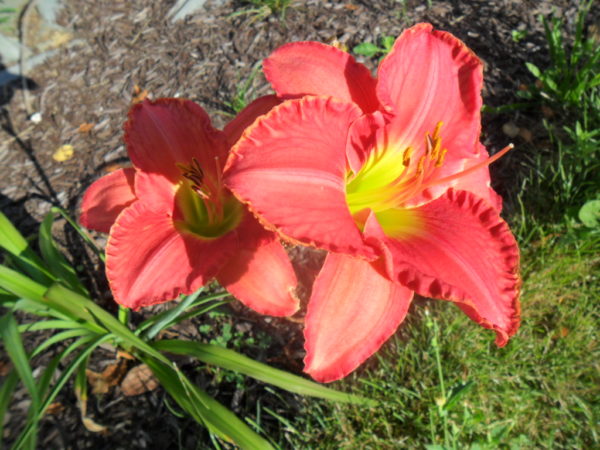
For some, the term “Scottish Fantasy” might conjure images of tear-away kilts, but this rose-pink daylily has come to be one of my new favorites

“Storm Shelter” is one of the more dramatic new varieties, with its two-toned purple petals in lilac and blackberry, and lime green throat
As feared, based in earlier performance, much of the bareroot stock which arrived in May and June failed to emerge; I can get a credit on the plant material, but the labor cost to install is gone for good. I’m very grateful that 4 of 5 of the new bleeding hearts sprouted – none have bloomed (it was very late in their season before they arrived), but they’re healthy and show promise of lovely blossoms next spring. The other variety that did well was the crocosmia, another special favorite of mine. They are sending their spear-like leaves vigorously skyward, and still have plenty of time to mature and bloom this first season. The echinacea have also thrived, and are just coming into bloom now; these will be August’s glories, along with the Mexican sunflower, heliopsis and the annuals which should be at their peak this month.
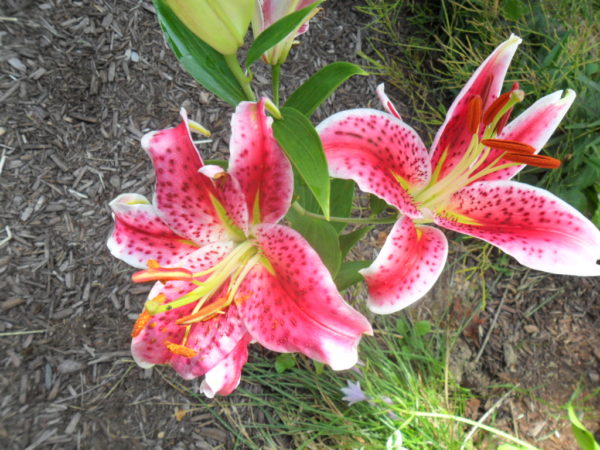
“Stargazer” is an old heirloom daylily variety, none the worse for wear; its vibrant color scheme makes plain why it remains a popular favorite
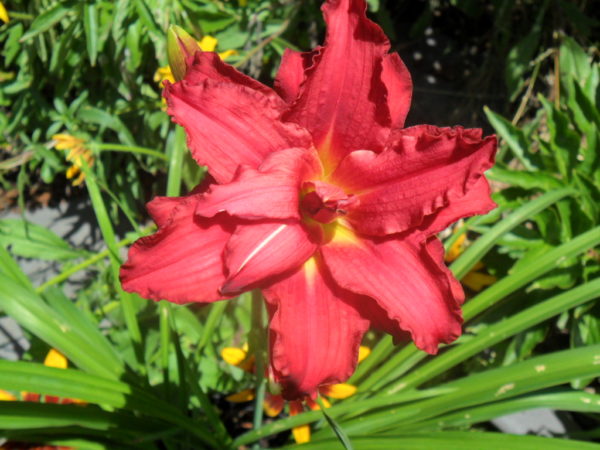
No excuse required for “Double Pardon Me”, a prolific brick-red bloomer with smaller, delicate blossoms
But nothing of the bareroot heuchera, bee balm, hummingbird mint or butterfly weed have emerged, a huge disappointment. With all those gaps, I’ve started supplementing with more live plants bought from Kay or at garden centers. It’s more expensive than bareroot, but apparently, also more reliable. And I can handle planting a few at a time by myself, so I have assiduously scoured the local greenhouses a couple times each week, bringing back just what I can manage per “big dig”.

This dense mat of a creeping portulaca stays low and spreads voluminously, with its spoon-shaped leaves studded by hot pink blossoms; drought tolerant and sun-loving, this superb annual will be tops on my list in years to come
This attentiveness has started to pay off, with lovely spots of color across the garden – two-tone rudbeckia (AKA “Brown-eyed Susan”); delicate blue daisy and aster; ferny yellow Zagreb coreopsis; creamy white Shasta daisy; willowy lavender scabiosa; and more hot pink portulacas than you can shake a walking stick at! Portulaca are succulents which thrive on the hot, dry conditions here, and these have done so well this season, they’ll be my main go-to summer annual for years to come.
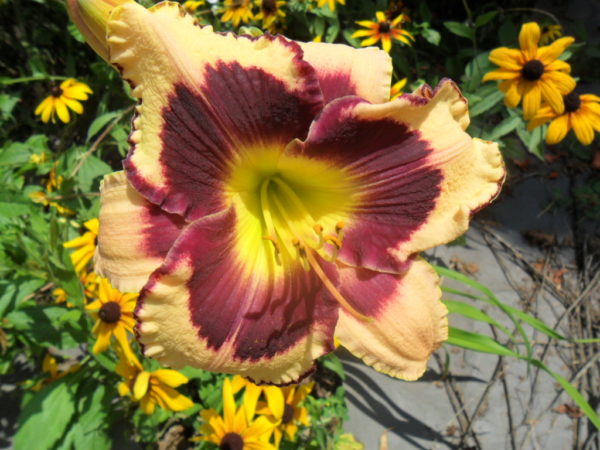
Inkheart is another study in dramatic contrast, echoed by the paler, smaller Baby Moon Cafe, pictured below
The impatiens, in tones of coral, pink and purple, were misplaced in too much sun, and have required constant watering, but are doing very well. I compensated for my mismanagement by placing the redwood picnic table benches over top of them, to shade them from the worst of the midday sun, and that’s helped a lot. Of course, it also means I can’t see them very well, but I know they’re there!
Some of the hostas are also badly positioned, and are burning out in the sun, so will have to be moved this fall. I planted them under the dense maple shade – a no-brainer, right? But the maple hadn’t yet leafed when I did this, and I didn’t realize that its very high canopy meant that even plants which were directly underneath it would be receiving 5-6 hours of full sun before its shade kicked in. And that’s too much for my delicately-colored hostas, which are fading to straw tones and require constant hydration just to survive.

Color contrast in the garden keeps things lively. This blue daisy makes a great pairing with its neighbor, Burning Hearts heliopsis
Well, live and learn! There’s an old saying that it isn’t a true garden until everything has been moved at least three times, and I’m finding that to be true.
One of the best performers this season has been an old favorite from my parents’ era: a gorgeous fire-red daylily we always called “Flame Lily.” Thanks to the display gardens at House of Lilies, I now know that it is correctly identified as “Sammy Russell”, deep red-orange with a yellow throat. These were moved from the foundation plantings when we took up the sod last year, divided into five groups and set in a semi-circle front and center on the northern slope of the sand mound. Their bloom season has been stunning and extended for weeks; at times it looked like the garden was on fire, their blossoms were so prolific. They added tremendously to the feeling of maturity for my first-year garden. I will begin dividing them next year, and establishing further colonies throughout the yard.

A scythe of “Flame Lily” (AKA “Sammy Russell”) cuts a swath of burning color across the middle garden
My birthday is July 27th, and I was gifted this year with a beautiful outdoor bouquet – my single cane on the aptly named “Buttered Popcorn” daylily sported three blossoms all opened at once, the only new daylily to do so. Of course, I took cuttings of other flowers for an indoor bouquet as well, another advantage of flower gardening. There are always crossbred daisy varieties in bloom at this time of year, in various banded versions incorporating yellow, orange, red and even brown. With accents of a few Queen Anne’s Lace and some the smaller stalks of Tiger Lily, and lots of purple coneflowers from the old wildflower garden outside the fence, a very passable Lammas bouquet can be made.
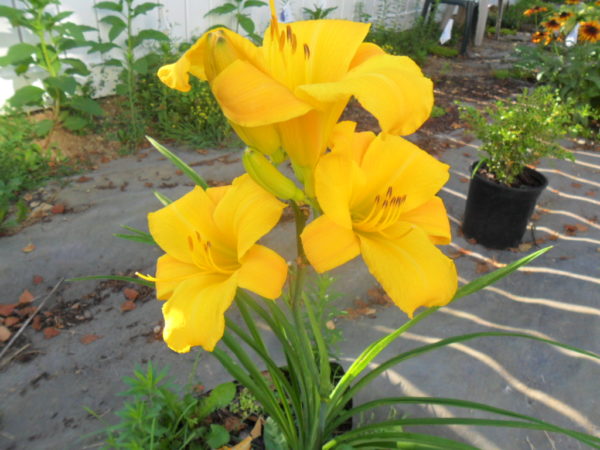
“Buttered Popcorn” formed a triple-headed bouquet for my birthday, the only daylily to produce three blooms at once on a single cane
Queen Anne’s Lace is one of my favorite “weeds” which I allow to flourish in the garden. Others included are fleabane, rocket and pink clover in the spring; pokeberry and lupine in the summer; and white snakeroot, goldenrod and stiff aster in the fall. But my all-time favorite is mullein, commonly known as “witches’ candle.” These dramatic weed skyscrapers sport a long candlelike blossom composed of tiny blooms which flower individually along the “candle”, which resembles a flickering flame. My first summer here a magnificent witches’ candle volunteered itself just at the base of my kitchen stoop steps; it must be 8 feet tall.

Mullein, also known as “witches’ candle”, makes a dramatic statement by the back stoop; this specimen is over eight feet tall, and derives its name from the habit of blooming sparsely at random intervals along its blossom stalk, resembling a flickering candle, as seen in the detail below
And I’ve gotten another bonus crop! Last autumn I spiked the fence with tiny jack-be-little pumpkins on each post facing the road, some dozen in all. When these had started to rot, instead of tossing them in the garbage, I purposely strew them in areas of the garden I knew I wouldn’t be developing strongly this year, hoping as they disintegrated into the soil, their seeds would take root and sprout.

Seeds from two of my discarded mini pumpkins last fall sprouted and took root along the east fence; they have now started to produce small fruits which will swell to about 4″ in diameter, though their exact color at maturity is as as yet undetermined
And my gambit paid off – in late May two huge mounds of pumpkin seedlings emerged on the east side, future home of a planned shaw of holly and winterberry. These have spread all along the fence and are now blooming heartily, with small fruits beginning to form. My plan is to place a mini pumpkin on each of the 37 fence posts this fall, utilizing them all now that I’m living here, and with any luck, these bonus plants will provide most of the required number.

A quick Lammas bouquet, taken from cuttings in the garden, featuring Queen Anne’s Lace, brown-eyed Susans, hosta blossoms and daylilies
Culinarily, Lammas features grain and corn products, along with fruits of the season – blackberries, blueberries, peaches and other stone fruit such as plums, nectarines and apricots. In my family’s Pennsylvania Dutch culture, it’s traditional to make string beans and ham, chicken pot pie, chowchow and shoofly pie sometime during the month of August. I’ve added pesto pasta salad, eggplant parmesan and peach pie to the repertoire, based in the predominance of basil, eggplant and peaches at this time.
String beans and ham is a sort of brothy soup, typically started with a ham hock or meaty ham bone which is simmered in water to cover until a thin broth has been yielded. The ham is then removed, cooled, and shredded or cut into small pieces, while beans (I use both green and yellow wax beans) and cubed potato are added to the broth and cooked until just tender. Some versions include fresh corn kernels cut from the cob, and older folks still “spike” their servings with a splash or two of apple cider vinegar, to give a quick punch of sour tang to the otherwise fairly tame soup.

Toad Lily is a rare shade bloomer, previously unknown to me, which has performed very well in the dappled light under the birch; its flowers are almost orchid-like
It’s traditionally served with corn muffins or cornbread, sometimes sourdough slathered with molasses, and chowchow (AKA “piccalilli”), a pickled relish condiment. The PA Dutch version of this features various veggies of the season, such as celery, carrots, pearl onions, corn, green and yellow beans, red peppers and cauliflower, plus kidney or great northern beans, all swimming together in a tart, sour, vinegar-based brine.

Blanket Flower, AKA Gaillarda, sets a fresh new crop of blossoms when the spent ones have been removed, for cycle after cycle of bright bloom throughout the growing season
Molasses also shows up in shoofly pie, a sweet treat with a crumb topping, supposedly so-named from the farmer’s wife having to constantly shoo persistent flies from landing on it as it cooled on a window ledge or unscreened back porch. Recipes for this are cherished family heirlooms, and often incorporate highly guarded secrets for how to keep a “wet bottom”, a gooey unbaked layer just above the piecrust which is much prized by locals.
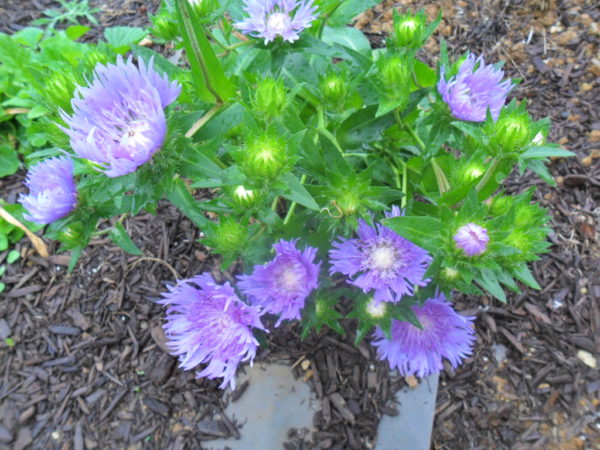
Blue aster is another new variety for me; it requires a little more watering than I’d like, but the payoff is worth it
Chicken pot pie is perhaps my favorite offering of the season. Not a meat pie, it’s actually a stew made on the stove, begun by browning a cut-up chicken until golden, then adding water or broth and simmering until done. As with string beans and ham, the meat is then removed and cut into bite-sized pieces, while onions, carrots, celery and potatoes are simmered in the broth, and pot pie squares are added. These are a thin egg noodle product, about 2” square, and the best versions are made fresh, though several local companies still offer a dried variety as a valuable time-saver. When I make my own, I add a quantity of fresh thyme to the dough, (though this would have horrified my grandmother), but traditionally only chopped parsley is used to flavor the stew at the last minute. If the pasta starch is insufficient to thicken the broth (and often it isn’t), a flour slurry or beurre manie can be used to get the right consistency. Again, corn muffins, chowchow or Harvard beets are traditional accompaniments.

Two new echinacea (coneflower) colors are white and orange; planted with pink and purple varieties, they make for a lovely color palette, prized by butterflies and gold finches alike
My family’s peach pie recipe is a little unusual in that it utilizes an egg-sugar filling amongst the fruit. Prepare (or purchase, as I do) one 9” piecrust, and spread in a glass plate sprayed with a flavorless cooking spray, such as canola oil. Peel, halve and pit 5-6 ripe peaches, depending on size, and place the halves pit side up in the pie. You’ll likely have at least a half peach remaining, possibly more; cut these into smaller chunks to fit in the gaps between the halves, and between them and the piecrust rim.
Mix 1 tablespoon of flour into two beaten eggs, add a pinch of salt, a cup of sugar, and 2 tablespoons of melted butter which has been cooled. Mix well to incorporate and pour over the peaches. Wrap the exposed crust rim with strips of aluminum foil, then bake in a preheated 425 degree oven for 10 minutes; reduce heat to 375 and continue baking until filling is set and just starting to brown and peaches are tender, approximately 30-35 minutes more.
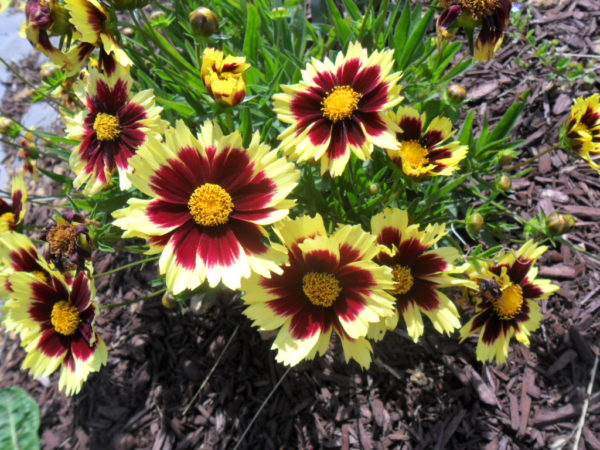
A coreopsis banded in pale yellow and dusky burgundy winks cheerily, like someone applied too much ‘smoky eye’ effect
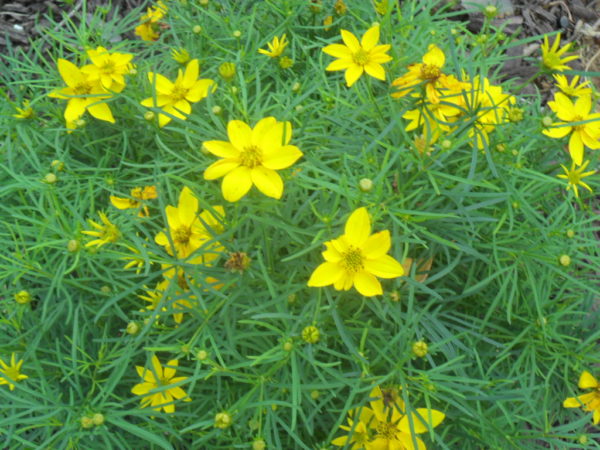
Ferny “Zagreb” coreopsis adds a bright punch of buttercup yellow to the landscape, blooming randomly but extensively throughout the season
Lammas is also a time for brewing beer, with hops and barley coming into maturity. And beer justly forms a large part of many pagan celebrations of the holiday, along with mead, a fermented honey-based beverage. Growing up in a teetotal family, I’m not used to alcoholic libation as a form of celebration, but let’s just say I’ve adapted over the years. My favorite summertime refresher lately is Angry Orchard’s Rose hard cider, made from pink-skinned apples. In the autumn I make a point of trying a s many new and unusual hard ciders as I can find, but this rose variety makes a perfect accompaniment to meals in the summer swelter.
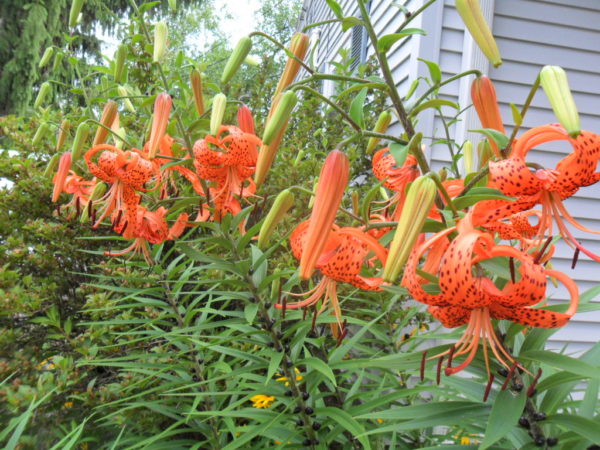
A detail of the massive tiger lily planting, a relic from my parents’ day which is still a superb performer; these stalks are taller than me, but never require staking
Once Lammas passes, we’re over the hump of summer. The days start to grow visibly shorter, the nights are just a bit cooler, and rainfall starts to increase as we head into the autumn. But there’s still plenty of heat and humidity, and the bonanza of fresh produce continues well into September. For me, the craziness of fall decorating begins on August 15th, as dozens upon dozens of boxes are retrieved from the basement, taking weeks to position. Ideally, I’ve finished that work by summer’s unofficial end on Labor Day, so I can enjoy its serene loveliness for a few scants weeks before the true insanity of Halloween decorating begins…
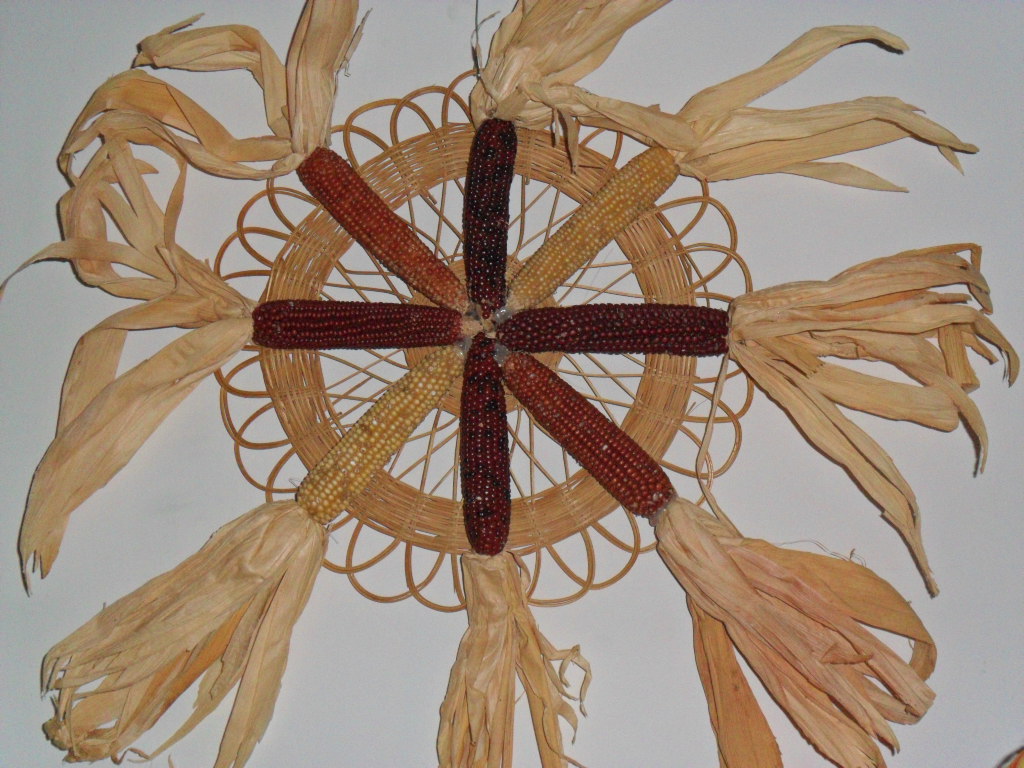
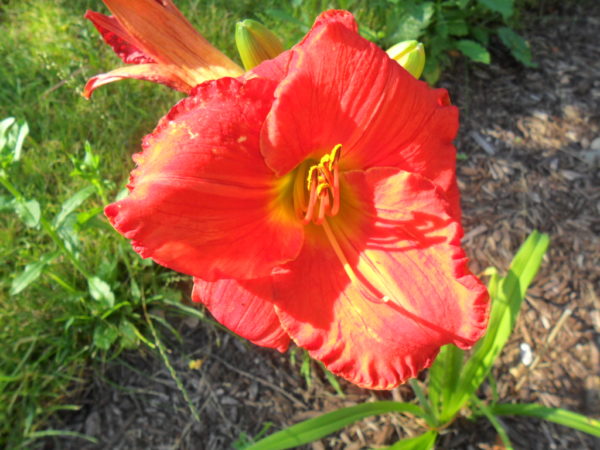
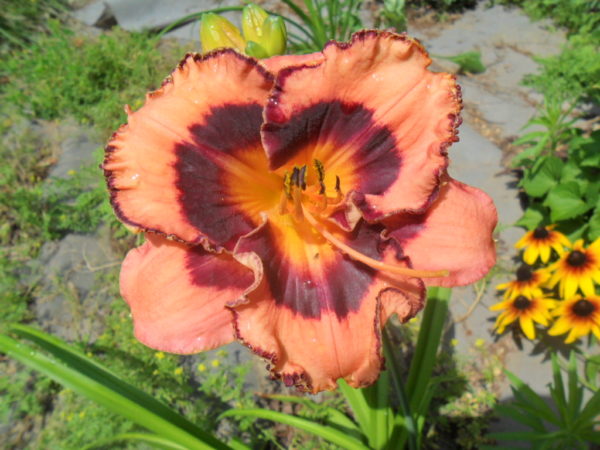

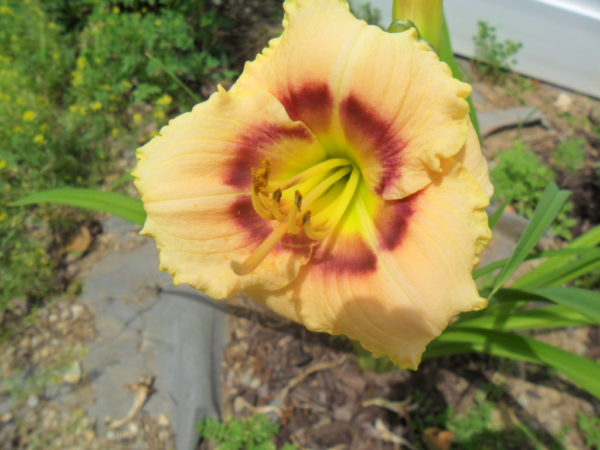
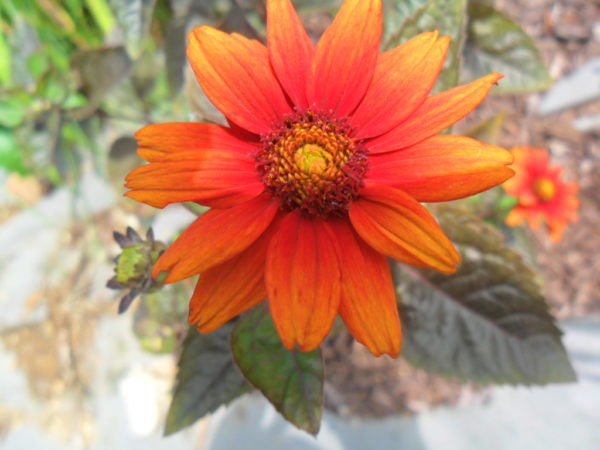

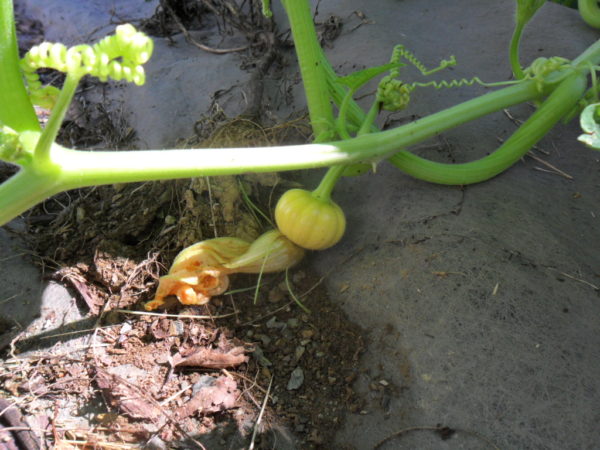

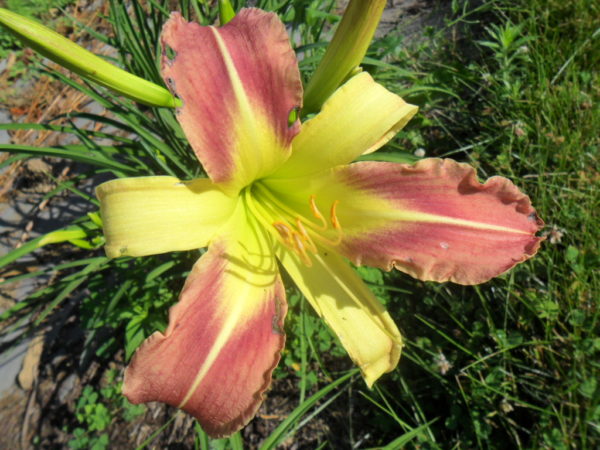


2 comments, add yours.
edna
Just loverly! I enjoy these mememe posts very much – thank you for sharing, Alex.
Kirsten
Beautiful flowers and photos, thanks for sharing them! Happy Lammas to you!